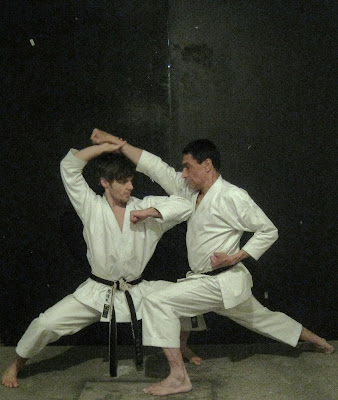.+March+7th.JPG) One term you will hear a lot in Japanese karate dojo is "Mou ikkai" or "One more time". However, you'll soon realise to ignor it! Consider weight training… A foundational routine includes three sets of 8-12 repetitions of an exercise. So, if say looking at a 'preacher curl', that works out to be 24-36 repetitions per arm (48-72 in total).
One term you will hear a lot in Japanese karate dojo is "Mou ikkai" or "One more time". However, you'll soon realise to ignor it! Consider weight training… A foundational routine includes three sets of 8-12 repetitions of an exercise. So, if say looking at a 'preacher curl', that works out to be 24-36 repetitions per arm (48-72 in total).________
Taking this into account, and applying this to karate technical training as the Japanese do, and it is easy to see that most Western karate schools fall far short of these repetitions. In most

traditional dojo in Japan, the start of the class typically features 50-100 stationary chudan gyaku zuki or jodan kizami-zuki kara chudan gyaku-zuki, followed by the 30-50 stationary mae-geri each leg. I think that alone answers the 'magic question' (within many karate circles), “
Why is the average Japanese karateka typically better?” It is certainly not because of their nationality, physique etc.., and this is proven by the many talented non-Japanese karateka all over the world. It is ‘how they train’, and this has three core dimensions:
(1) The quality of training they receive (easier access to high class/gifted coaches) and greater larger pools of high quality training partners;
(2) the cultural aspect of `just doing, not questioning’, whilst coming up through the grades (right up to and including the middle dan ranks). This is what I call the “Just shut up and train mentality”; and last, but certainly not least
(3) "Mou ikkai"... The repetitions! Imagine the average
`recreational’ Japanese karateka doing their 60 gyaku zuki per night (training say, a modest four nights a week). That’s 240 a week… 960 per month! This point cannot be overlooked.
________

My advice is to never do less than 30 `good repetitions’ of anything when you are seriously practicing kihonwaza (fundamental techniques). Obviously this can also be applied to technique/sequences from the kata, such as the mawashi-geri from the ground from Unsu, chudan morote-uke in Heian-godan and nami-ashi from Tekki-shodan. Of course this even more so applies for kumite (sparring) and goshin-jutsu (self-defence) as the elements of distancing, timing, psychological control, and so forth, are added to the equation.
________
If a technique, kata or application is giving you trouble, just train until you get it right. Keep practicing and the answer will come, and if not, during your recovery times, seek advice and study. However, drop the `Western mindset' that study and mental understanding is training, because IT ISN'T. Everything understood by the mind most be done repetitively by the body. That is, to be effective, the motivation of the study/advice seeking must originate from physical training. Once mentally understood, it is put into physical practice (= REPETITIONS). This is the cycle of development in karate, but never forget, that repetition is the pedalling, and without pedalling, the wheels on the bycycle will not move. "Mou ikkai!" "OSU!!!"
understood, it is put into physical practice (= REPETITIONS). This is the cycle of development in karate, but never forget, that repetition is the pedalling, and without pedalling, the wheels on the bycycle will not move. "Mou ikkai!" "OSU!!!"
© André Bertel. New Zealand, 2010.
 In this photo I am performing the sankaku-tobi (triangle jump) at the end of the first Meikyo kata. This technique when done correctly turns disadvantage into advantage, via a three point aerial change of position. It is not a complicated movement, however, if done correctly will allow one to maximise momentum, body weight and the element of surprise. After perfecting this technique one can utilise many variations such as that depicted below by my late teacher Shuseki-Shihan Asai Tetsuhiko (10th Dan).
In this photo I am performing the sankaku-tobi (triangle jump) at the end of the first Meikyo kata. This technique when done correctly turns disadvantage into advantage, via a three point aerial change of position. It is not a complicated movement, however, if done correctly will allow one to maximise momentum, body weight and the element of surprise. After perfecting this technique one can utilise many variations such as that depicted below by my late teacher Shuseki-Shihan Asai Tetsuhiko (10th Dan). shinai at you! Needless to say, Asai Sensei helped me to refine my tobi-waza.
shinai at you! Needless to say, Asai Sensei helped me to refine my tobi-waza. shinai at you! Needless to say, Asai Sensei helped me to refine my tobi-waza.
shinai at you! Needless to say, Asai Sensei helped me to refine my tobi-waza.



.+March+7th.JPG)




















 Paul Kallender just wrote an excellent article on my late teacher Tetsuhiko Asai's tokui-gata, NIJUSHIHO. I was honoured to contribute to this post, especially in relation to Asai Sensei, as I have many special memories of him performing (and "applying") this Shotokan-ryu kata.
Paul Kallender just wrote an excellent article on my late teacher Tetsuhiko Asai's tokui-gata, NIJUSHIHO. I was honoured to contribute to this post, especially in relation to Asai Sensei, as I have many special memories of him performing (and "applying") this Shotokan-ryu kata. 




